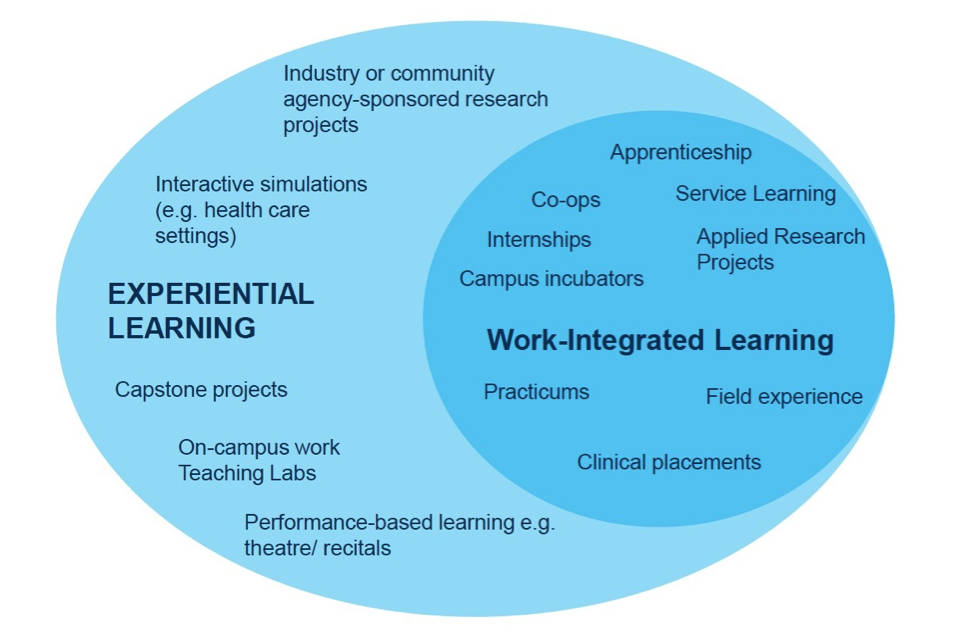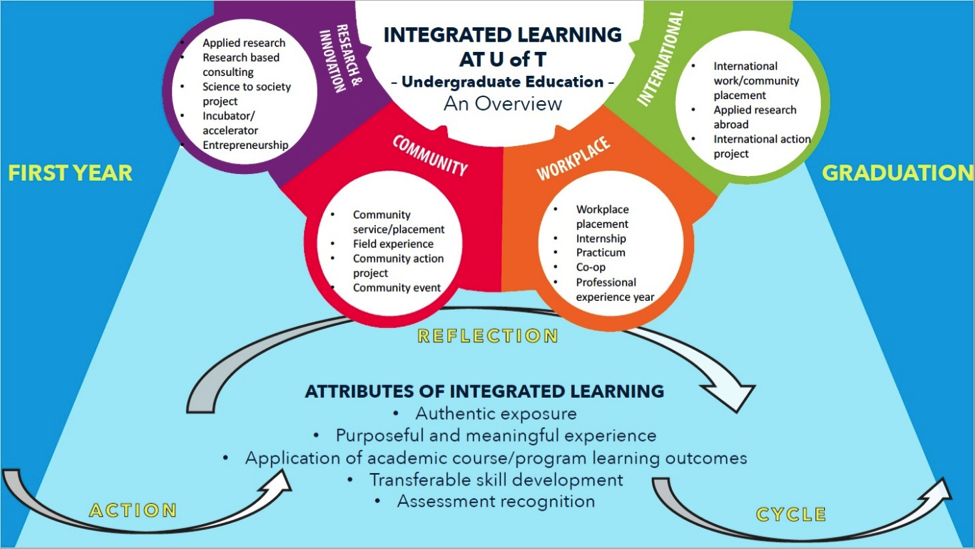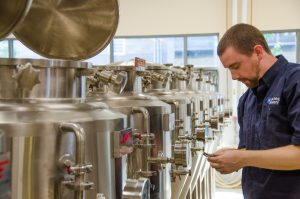Introduction
Experiential education, or learning by doing, takes many forms and experiential learning activities can be embedded in a postsecondary course, comprise an entire course, or serve as the focus of a complete term of study. Experiential learning can be introduced early on in a program of study to provide students with early exposure to authentic experiences tied to their discipline or related professions, built into the upper levels of a program to give students an opportunity to experiment with applying what they are learning in their courses, or set as a capstone experience to help launch them into the world of work prior to graduation.
Experiential education is common in higher education and increasingly, colleges and universities in Ontario are concentrating their efforts on providing students with experiential learning opportunities situated within simulated or actual workplaces with the aim of giving students authentic exposure to work environments so that they can really judge well what skills are needed and what the work environment is like on a daily basis. The Ontario Ministry of Advanced Education and Skills Development has provided a useful diagram for understanding experiential education:

source: Ministry of Advanced Education and Skills Development. (2017). MAESD’s Guiding Principles for Experiential Learning: Experiential Learning Overview. Retrieved from http://hive.utsc.utoronto.ca/public/dean/academic%20administrators/DCD%202017-18/A04%20EL%20-%20Guiding%20Priciples%20FINAL%20EN.pdf
Many Ontario colleges and universities are considering how the full scope of experiential learning opportunities across program areas correspond to this graphic representation of experiential education provided by the Ministry. However, some institutions have contextualized their vision of experiential learning to align more closely with institutional priorities and values. For example, the University of Toronto has generated an informative graphic representation of experiential education, or what they refer to as “Integrated Learning.” Consider the similarities and differences between the University of Toronto model and the Ministry of Advanced Education and Skills Development graphical representation of experiential learning.

source: C. Rolheiser, personal communication, November 17, 2017.
As becomes evident when considering graphic representations of Experiential Education such as those provided by MAESD and University of Toronto, there are many forms of experiential education and settings for experiential learning are varied and can take place in campus classrooms, labs, studios, theatres, incubators, as well as at sites throughout the community surrounding the college or university or beyond through travel abroad opportunities. Also, the conceptualizations of experiential education may vary slightly from one postsecondary institution to the next to reflect institutional cultures and priorities, but there is considerable commonality in the commitment to experiential education across institutions. Colleges and universities value experiential education for the ways in which it can contribute effectively to the development of students’ sense of competence and confidence in their chosen field, and can help students to recognize their own passions, knowledge and skills and chart a clearer path for their own career growth and advancement. As the Honourable Mitzie Hunter, Minister of Advanced Education and Skills Development stated in 2017,
“Ontario’s students are highly-educated and incredibly talented, but without some work-related experience on their resume, it can be challenging for them to land that first job after school. With support from the Career Ready Fund, students and new graduates will gain the meaningful, real-world experience they need for a successful career start, and employers will have access to talent that can make an immediate impact on their success.”
(source: D. Bartucci, personal communication, April 27, 2018)
Given the Ontario government’s focus on investing in diversifying the economy and improving the employment picture for postsecondary graduates, there is currently an emphasis among colleges and universities on expanding the ways in which experiential education can contribute to preparedness for the world of work. Work-Integrated Learning (WIL) opportunities, which are a form of Experiential Education, are a particular area of focused development. WIL is an umbrella term used to describe a range of educational activities that integrate learning within an academic institution with practical application in an authentic or simulated work setting relevant to each student’s program of study or career goals. WIL takes many forms, with varying degrees of integration and a multitude of characteristics.
The following key principles distinguish WIL initiatives from other experientially focused (EL) learning and co- and extra-curricular activities. According to the Ontario Ministry of Advanced Education and Skills Development, WIL initiatives:
- Occur in a workplace or simulated workplace
- Expose students to authentic workplace demands
- Enable students to apply program subject matter knowledge and essential employability skills
- Include structured, purposeful activities and reflection
- Are evaluated and counted towards course credit or credential completion (OR evaluated and formally recognized by the institution as meeting the four criteria above. For example, engaging in an applied research project within a multidisciplinary team of students)
 While experiential learning (EL) is any learning that supports students in applying their knowledge and conceptual understanding to practical problems or situations, work-integrated learning (WIL) is considered to be a subset of experiential learning that meets two conditions: (1) involves an industry partner AND (2) takes place in an authentic or simulated work setting. Although diverse in its forms, WIL as a pedagogy, provides structured opportunities in curriculum “…whereby students come to learn from experiences in educational and practice settings and integrate the contributions of those experiences in developing the understandings, procedures and dispositions required for effective professional practice, including criticality.” (Billett, S. (2015). Integrating practice-based experiences into higher education. Dordrecht: Springer Netherlands.)
While experiential learning (EL) is any learning that supports students in applying their knowledge and conceptual understanding to practical problems or situations, work-integrated learning (WIL) is considered to be a subset of experiential learning that meets two conditions: (1) involves an industry partner AND (2) takes place in an authentic or simulated work setting. Although diverse in its forms, WIL as a pedagogy, provides structured opportunities in curriculum “…whereby students come to learn from experiences in educational and practice settings and integrate the contributions of those experiences in developing the understandings, procedures and dispositions required for effective professional practice, including criticality.” (Billett, S. (2015). Integrating practice-based experiences into higher education. Dordrecht: Springer Netherlands.)
Reviewing a selection of definitions for the common forms of Experiential Education, including Work-Integrated Learning Opportunities, may prove helpful in distinguishing the forms of EE. When reviewing these definitions, try to anticipate how these forms of EE might differ from one another and how they might be customized to fit particular aims within a college or university.

